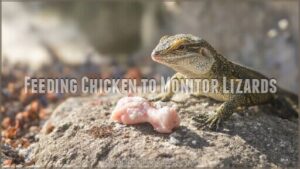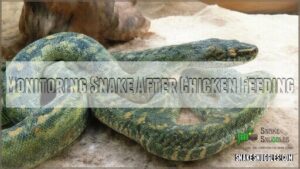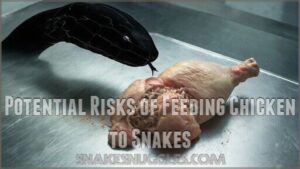This site is supported by our readers. We may earn a commission, at no cost to you, if you purchase through links.

It’s essential to handle the chicken safely to avoid bacterial contamination. When you’re preparing to feed your snake, make sure to research the specific needs of your species, as some, like ball pythons, have unique requirements.
Now that you’ve got the basics, you’re probably curious about the best practices for thawing and serving chicken to your slithery friend.
Table Of Contents
- Key Takeaways
- How to Feed a Snake Chicken?
- Can Snakes Eat Chicken?
- Preparing Chicken for Snake Consumption
- Thawing Chicken for Snakes
- Feeding Chicken to Ball Pythons
- Feeding Chicken to Boas
- Feeding Chicken to Monitor Lizards
- Monitoring Snake After Chicken Feeding
- Health Benefits of Chicken for Snakes
- Potential Risks of Feeding Chicken to Snakes
- Frequently Asked Questions (FAQs)
- Do snakes eat chickens?
- How do you keep snakes away from chickens?
- How do you feed a snake if it doesn’t want to eat?
- How do you know if a Chicken eats a snake?
- Do corn snakes eat chicken eggs?
- Do chickens eat garter snakes?
- Can I feed chicken to my snake?
- How do you properly feed a snake?
- What does a chicken snake eat?
- Can you feed a snake a chicken?
- Conclusion
Key Takeaways
- You’ll want to choose fresh, raw chicken and cut it into appropriate sizes for your snake’s species and age to ensure a healthy meal.
- It’s crucial to handle chicken safely to avoid bacterial contamination, so make sure to research your snake’s specific needs and follow proper handling and preparation techniques.
- You should consider your snake’s unique requirements, such as ball pythons needing a balanced diet with proper cooking methods and supplement needs, to guarantee a nutritious meal.
- After feeding your snake chicken, you’ll need to monitor its digestion and watch for signs of regurgitation, allergy symptoms, or digestive issues to ensure your pet stays healthy.
How to Feed a Snake Chicken?
To feed a snake chicken, choose fresh, raw meat without additives.
Choose fresh raw chicken for a healthy snake meal
Cut it into appropriate sizes for your snake’s species and age. Thaw chicken completely, preferably in the refrigerator.
Consider chicken alternatives and ethical sourcing. Guarantee a balanced snake diet with proper cooking methods and supplement needs.
Feed your snake chicken safely by following these guidelines and researching wild snakes’ diets for inspiration.
Can Snakes Eat Chicken?
You’re wondering if snakes can eat chicken.
Snakes can eat chicken as a nutritious part of their diet
The answer is yes, many snakes can safely consume chicken as part of their diet.
It’s a nutritious option providing essential proteins and fats.
Consider your snake’s species, size, and natural feeding habits.
Ball pythons, boas, and monitor lizards can enjoy chicken.
Chicken offers high nutritional value, but make safe preparation to maintain your snake’s health.
As a chicken alternative prey, it’s vital to assess snake species suitability.
Remember, a balanced diet is key, so explore wild snake diets and chicken nutritional value to make informed decisions for your pet’s snake diet chicken needs, and consider the importance of natural feeding habits.
Preparing Chicken for Snake Consumption
When preparing chicken for your snake, consider these steps:
- Choose fresh chicken
- Cut it appropriately
- Store it safely.
Bacterial contamination is a primary concern when feeding raw chicken.
Make certain chicken sourcing is reputable, and use proper cutting techniques for safe handling and storage, ideal for a snake diet including chicken, to prevent bacterial contamination.
Thawing Chicken for Snakes
When thawing chicken for your snake, consider safe thawing methods.
The refrigerator method is safest, while the cold water method is quicker.
Avoid microwaves, as they can introduce bacteria.
Thawing times vary, so be patient.
Speed vs. safety is key, with thawing temperatures vital in preventing bacteria.
Proper methods guarantee safe chicken thawing.
Choose the refrigerator or cold water method for safe thawing, and never use hot water or a microwave to guarantee your snake’s health and safety.
Feeding Chicken to Ball Pythons
When caring for ball pythons, you’ll want to take their unique needs into account.
- Determine the right chicken size
- Establish a feeding frequency
- Assess supplementation needs
- Decide between raw or cooked chicken
- Monitor digestion signs
For ball pythons, chicken can be a nutritious addition to their diet, but it’s vital to get it right.
It’s key to recognize that raw chicken may carry risks, requiring careful preparation.
You’ll need to balance chicken with other protein sources to guarantee a healthy snake diet.
Feeding Chicken to Boas
You’re feeding your boa chicken, adjusting size and frequency by age.
| Boa Age | Chicken Size | Feeding Frequency |
|---|---|---|
| Young | Small | Often |
| Adult | Large | Less |
Consider baby chicks as a nutritious option, supplementing with other foods for a varied diet.
You can find products related to boa chicken size.
Feeding Chicken to Monitor Lizards
Moving from boas to monitor lizards, you’ll find that chicken can fit into their diet, but it’s not as simple as tossing any chunk their way.
Pay attention to Chicken Portion Sizes—young lizards need smaller bites, adults can handle a bit more.
Sprinkle a little calcium powder for Nutritional Supplementation, since strong bones matter for all Monitor Lizard Species.
Mix in Alternative Proteins like insects and lean meats.
Keep good Hygiene Practices, and always use fresh chicken for snakes, as you’d for any snake food.
Monitoring Snake After Chicken Feeding
After your monitor lizard’s feast, it’s time for some feeding monitoring on your snake.
Snake feeding isn’t just “feed and forget”—you’ll want to master digestion observation like a pro.
Keep your eyes peeled for these three things:
- Spot a bulge in the midsection—that means a happy, full snake.
- Watch for sudden behavior changes or regurgitation signs (nobody likes leftovers coming back up).
- Expect regular defecation and use occasional fecal analysis to detect allergy symptoms or digestive hiccups.
Snake behavior tells a story—stay alert to detect allergy symptoms and notice regurgitation signs for a happy and healthy pet.
Health Benefits of Chicken for Snakes
When you feed your snake chicken, you’re giving it a source of lean protein and important nutrients with every bite.
Chicken keeps your snake’s muscles strong and energy up—plus, it’s not quite as messy as wrangling live mice, which makes chicken a practical choice for snake owners who want to provide their pets with a nutritious and convenient meal.
Protein and Fat Content
You’re evaluating chicken as a protein source for snakes, considering fat ratios and chicken digestibility.
Chicken provides a protein-packed meal, supporting growth with lean protein and moderate fat content, making it a suitable option for snakes when prepared correctly.
Essential Nutrients Provided
You’re boosting your snake’s health with chicken, which provides essential nutrients like Chicken Vitamins, Minerals, and Omega-3 Benefits.
Key benefits include:
- Complete Protein
- Balanced Diet
- snake nutrition
Chicken offers a nutritional punch, supporting overall health with its protein content.
Digestibility for Snakes
You’ll want to take into account the digestibility of chicken for your snake, as species differences affect digestion time and enzyme production.
This affects the digestive system and potentially causing digestive issues if not prepared ideally.
Potential Risks of Feeding Chicken to Snakes
When feeding your snake chicken, be aware of potential risks.
You face bacterial contamination, specifically salmonella risk, and parasite risks.
Consider these hazards:
- Bone hazards from splintered bones
- Digestive problems from improper preparation
- Nutritional imbalance from over-reliance on chicken.
To minimize risks, make certain proper handling and preparation, and maintain a balanced diet to avoid nutritional deficiencies and digestive issues.
Rodents are often a safer choice, but if you choose chicken, consult a vet to verify you’re providing the right nutrition without putting your snake at risk of bacterial infections or parasite risks.
Understanding snake feeding basics is vital for a healthy pet snake.
Frequently Asked Questions (FAQs)
Do snakes eat chickens?
Like a puzzle piece, you’re wondering if snakes eat chickens.
Yes, some snakes do, like Burmese pythons or corn snakes, but it’s not a common food source for all species.
How do you keep snakes away from chickens?
You secure chickens in enclosures, remove attractants, and seal entry points to keep snakes away, protecting your flock with simple, effective measures.
How do you feed a snake if it doesn’t want to eat?
You try different prey, consult a vet, and make certain proper environment, as picky snakes may refuse food due to various reasons, including health or habitat issues.
How do you know if a Chicken eats a snake?
You’re the detective, and it’s unlikely a chicken eats a snake, as snakes are predators, and chickens are prey, so it’s probably the other way around, naturally.
Do corn snakes eat chicken eggs?
You’ll find corn snakes don’t typically eat chicken eggs, as they prefer live prey like mice or rats, but some may accept eggs as an occasional treat or supplement.
Do chickens eat garter snakes?
You won’t typically see chickens eating garter snakes, as chickens usually peck at grains, insects, and small invertebrates, not snakes, in their natural foraging behavior.
Can I feed chicken to my snake?
Like a puzzle piece, chicken can fit into your snake’s diet, but consult a vet first to confirm it’s a good match for your slithery friend’s needs.
How do you properly feed a snake?
You properly feed a snake by offering prey items that match its girth, providing a balanced diet with varied sources, and maintaining proper hygiene and handling practices always.
What does a chicken snake eat?
Savvy snake owners, you’re curious: chicken snakes eat small mammals, birds, and lizards, not chicken, surprisingly, preferring warm-blooded prey to poultry.
Can you feed a snake a chicken?
You can feed a snake chicken, but make certain it’s fresh, raw, and properly sized for the species and age, and consider consulting a vet for specific dietary recommendations.
Conclusion
Literally, feeding your snake is a breeze once you master the basics.
You’re now a pro at knowing how to feed a snake chicken, so go ahead, cook, and serve.
Remember, handling chicken safely is key to avoiding bacterial contamination, and researching your snake’s needs is vital when learning how to feed a snake chicken.













